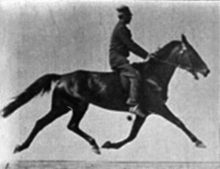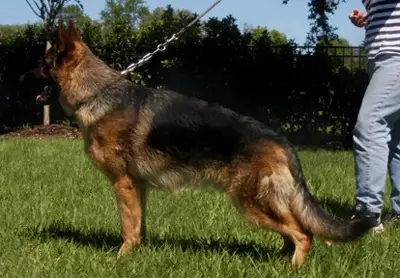
This is a placeholder text
Group text
by mklevin on 14 October 2014 - 03:10
https://www.youtube.com/watch?v=fN7TopAIw0U
Watch the video.Watch the shepherd run in it. Then watch at the three minute mark as he struggled to climb the pallisade, then hooks his hocks on it and flips over it onto his head and back.
Then tell me the structure isn't affecting their ability to work. I've seen those problems in the show lines for far to many years
by foreversolucky on 14 October 2014 - 03:10
Totally disagree that it's not a natural gait. I rode a Quarter Horse who would pace when he wanted to get somewhere and you didn't allow a trot. No fun to ride - I guarantee you no one taught him that!
My WL paces like a fiend, and I don't believe he's overangulated. 13.5 months in this picture - has matured a lot since but I don't have an updated pic. Ibrahim and others, feel free to critique! We're going to an SV show soon and I'm counting on the handler's skills to get him gaiting correctly.

by Hundmutter on 14 October 2014 - 05:10
I don't believe the video proves anything. I have seen more than one dog get a hock hooked at the rear coming
over the scale, and make a less than tidy landing. They weren't all German Shepherds.
by Blitzen on 14 October 2014 - 06:10
http://cal.vet.upenn.edu/projects/saortho/chapter_91/91mast.htm#normals
Pace[edit]

Pace
The pace is a lateral two-beat gait. In the pace, the two legs on the same side of the horse move forward together, unlike the trot, where the two legs diagonally opposite from each other move forward together. In both the pace and the trot, two feet are always off the ground. The trot is much more common, but some horses, particularly in breeds bred for harness racing, naturally prefer to pace. Pacers are also faster than trotters on the average, though horses are raced at both gaits. Among standardbred horses, pacers breed truer than trotters – that is, trotting sires have a higher proportion of pacers among their get than pacing sires do of trotters.[14]
A slow pace can be relatively comfortable, as the rider is lightly rocked from side to side. A slightly uneven pace that is somewhat between a pace and an amble, is the sobreandando of the Peruvian Paso. On the other hand, a slow pace is considered undesirable in an Icelandic horse, where it is called a lull or a "piggy-pace".
With one exception, a fast pace is uncomfortable for riding and very difficult to sit, because the rider is moved rapidly from side to side. The motion feels somewhat as if the rider is on a camel, another animal that naturally paces. However, a camel is much taller than a horse and so even at relatively fast speeds, a rider can follow the rocking motion of a camel. A pacing horse, being smaller and taking quicker steps, moves from side to side at a rate that becomes difficult for a rider to follow at speed, so though the gait is faster and useful for harness racing, it becomes impractical as a gait for riding at speed over long distances. However, in the case of the Icelandic horse, where the pace is known as the skeið, "flying pace" or flugskeið, it is a smooth and highly valued gait, ridden in short bursts at great speed.
A horse that paces and is not used in harness is often taught to perform some form of amble, obtained by lightly unbalancing the horse so the footfalls of the pace break up into a four beat lateral gait that is smoother to ride. A rider cannot properly post to a pacing horse because there is no diagonal gait pattern to follow, though some riders attempt to avoid jostling by rhythmically rising and sitting.
Based on studies of the Icelandic horse, it is possible that the pace may be heritable and linked to a single genetic mutation on DMRT3 in the same manner as the lateral ambling gaits.[15]
by Ibrahim on 14 October 2014 - 06:10
Foreversolucky
A bi-color GSD male of very good type, above medium size, well balanced, rich pigment, good proportions, athletic build, good expression and head, good earset, a strong neck, beautiful topline, high withers, slightly long loin, very good croup length and lay, very good tail and tailset, good rear angulation but could use a bit more stifle turn, good strong hocks. Very good underline, good front angulation, front upper arm slightly steep, very good shoulder blade lay back, straight front and slightly soft pasterns.
A very good looking boy at his age. At this time he looks a bit stretched, when he fills out that impression of being stretched in the back will set right. His topline is correct and beautiful where withers, back and croup each makes good share. Loin is a bit long but does not take from back strength. His croup is close to perfection in length and angle and stands out as comolimentary to his total back/topline. Balance in a German Shepherd structure is vital and that boy has it in athletic substance, equilibrium between front and rear, head and neck/also front leg to total body length. Should he be mated to a female of same type but a bit deeper rear and a bit better shoulder angle a son or daughter might make a excellent example of GSD structure model. Good luck with him
by Blitzen on 14 October 2014 - 07:10
.jpg)
.jpg)
Same dog. A dog that tended to pace if not moved out fast enough.
by Ibrahim on 14 October 2014 - 07:10
Oh my God, that is what beauty is. I have ' nice conformation" fever.
I'm trying to imagine the outcome of that male offspring from this female, wowwwww
by Blitzen on 14 October 2014 - 07:10
by mklevin on 14 October 2014 - 09:10
Hundmutter, you need to watch the video closer. He gets the hock hooked because he lacks the power to get up the wall from the rear end. He pulls himself over with his front end. Gotta look at the cause, not just the effect.
by Hundmutter on 14 October 2014 - 09:10
MK Yes but that is about the power in the hind quarter assembly to jump the height, something which could be
discussed for years ! It isn't about the pace the dog is using. Nothing in the video shows any of the dogs to be
gaiting at full stretch, let alone pacing or ambling. (Some bunny hopping, yes ![]() ).
).
An Ob / Agility demo is hardly the place to assess gait. Put those dogs on a big flat field and run them
round in circles !
Actually none of the dogs in thev ideo seem to have problems jumping, as such - just a q. of height.
None flunked the burning hurdles.
Contact information Disclaimer Privacy Statement Copyright Information Terms of Service Cookie policy ↑ Back to top






